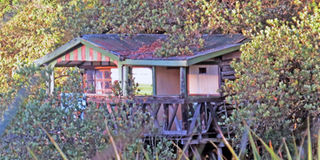OUT&ABOUT: The sitatunga of Saiwa

Tree house in Saiwa Swamp. PHOTO| MAYA MANGAT
What you need to know:
- The swamp-antelope is unaware of being watched and continues to feed on its favourite swamp-foods as the mist lifts.
- The hike through the swamp and along the forest edge is filled with anticipation.
- The only problem is that it isn’t an easy animal to photograph because it’s so swamped in the reeds.
It’s the last days of 2018 and we’re en route, in search of things still not seen over the many years. Topping the list is the sitatunga of Saiwa Swamp past Kitale.
The sitatunga is a strange, rare antelope of the swamps and the only protected area to see it is at Saiwa Swamp National Park that measures a paltry 2.9 square kilometres. It takes pride of place as Kenya’s smallest national park.
The journey so far has been exciting, leaving Nairobi before sunrise on Christmas Day and choosing the Eldama Ravine road to Eldoret, past Kitale and into the swamp-filled park. It’s a scenic, winding road between ancient forest straddling tall forest lobelias and overlooking the Kerio Valley.
The tree-house is free for the night and we jump at the chance to spend a night in it. The ethereal dawn comes, with mist shrouding everything in white.
The sitatunga rarely come this close to the tree house, I’ve been told. And so, as I rush to meet our guide to commence our search for one, I am surprised to hear an animal chomping on the glade below the tree house. I peer – and behold, it is an earth-brown sitatunga.
It’s the moment l’ve been waiting for.

Sitatunga in Saiwa Swamp. PHOTO| MAYA MANGAT
The swamp-antelope is unaware of being watched and continues to feed on its favourite swamp-foods as the mist lifts.
The hike through the swamp and along the forest edge is filled with anticipation. Will we or will we not see more of this rare creature that until the early 20th century was prolific around the swampy shores of Lake Victoria?
It proves to be a successful walk. By 8am we’ve seen five along the 11-kilometre nature trail from the watch towers.
The only problem is that it isn’t an easy animal to photograph because it’s so swamped in the reeds. With its splayed hooves that don’t sink in muddy ground, the antelope rules the swamp.
In the horizon, the long range of the Cherangany Hills is visible and it’s proving to be an exciting walk for the rare sitatunga shares its swamp with other animals that are also just as endangered. A trio of otters swim in Saiwa River flowing through the swamp.

Colobus monkeys at Saiwa Swamp. PHOTO| MAYA MANGAT
We startle a troop of 10 colobus monkeys sunning themselves on a log on the ground. Maya, my niece, manages to snap three as they flee to their towering trees. And to cap it off, a pair of the critically endangered Grey crowned crane fly above the green glade.
Chatting with Richard Barnley later in the day, I learn more about the sitatunga. Barnley, born and bred by the swamp, knows it better than most.
Before independence, most of the area was farmed by white settlers and the swamp a haven for the sitatunga. After independence, many settlers sold their large farms that teemed with wildlife.
Barnley’s father, the late Timothy, realised that with all the farms being sold out to small land owners, the sitatunga would be on a fast path to extinction.
He called on many of the farmers selling the farms to donate some land around the swamp to save the sitatunga. In 1974, the swamp was gazetted.
***
Sojourn at Saiwa Swamp
It’s an exciting destination 400 kilometres west of Nairobi. Combine the journey with the Cherangany Hills via Kapenguria (infamously famous for the trial of the Kapenguria Six – Bildad Kaggia, Kung’u Karumba, Jomo Kenyatta, Fred Kubai, Paul Ngei, and Achieng’ Oneko – the six leading Kenyan nationalists who were arrested in 1952, tried at Kapenguria in 1952–53, and imprisoned after that in Northern Kenya).
Continue to Lake Turkana. Or drive to Mount Elgon, the stunning volcano that is Africa’s fifth highest massif on the Kenya-Uganda border.
Kenya Wildlife Service is the custodian of Kenya’s national parks and has beautiful camping grounds and bandas at both national parks that are affordable. Make it your new year’s resolution to discover more of Kenya.
www.rupitheafricantrotter.wordpress.com




